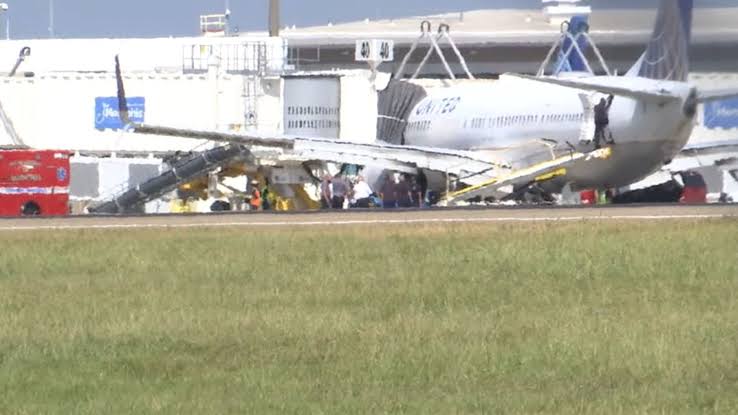Chaos in the Skies: 13 Injured During United Airlines Flight Incident
Chaos in the Skies: 13 Injured During United Airlines Flight Incident
On January 24, 2025, a United Airlines Boeing 787-8, Flight 613, embarked on a routine transatlantic journey from Lagos, Nigeria, to Washington, D.C.. What began as a standard overnight flight swiftly turned chaotic when the aircraft experienced a sudden, unexpected descent that shook both passengers and crew, resulting in 13 reported injuries aboard—a stark reminder that even routine flights can unravel without warning.
Sequence of Events
Shortly after reaching cruise altitude, the Boeing 787−8 suddenly dropped in altitude. Flight attendants serving a late-night meal were caught off-guard when beverages, food carts, and loose items were propelled across the cabin. Passengers, some in the restroom or walking through the aisle, were thrown off balance. Though the cabin crew promptly secured carts and assisted guests, injuries had already occurred. While 13 people—mostly with minor wounds—were reported, initial statements from Nigerian and U.S. authorities suggested a higher count. The U.S. Federal Aviation Administration (FAA) later confirmed the number settled at 13, including a small number with more serious injuries requiring in-hospital evaluation before safe discharge.
Video footage shared on social media captured passengers clinging to seats as the cabin jolted violently. Items fell from overhead compartments; food trays flew; and some were visibly shaken. A Lagos-based news service described how “baggage, belongings, trays of food and other items flew around the cabin,” underscoring the severity of the sudden drop .
What Caused the Sudden Drop?
In the resulting investigation, the U.S. National Transportation Safety Board (NTSB) and Nigeria’s Federal Airports Authority (FAAN) collaborated with United and Boeing to determine the cause. By mid‑March, the NTSB released preliminary findings indicating that on January 24, the aircraft’s autopilot disengaged after the failure of two critical inertial navigation units (IRUs) .
According to the NTSB, both left and right IRUs experienced simultaneous failure. This resulted in the autopilot disconnecting automatically. With no autopilot engagement, the aircraft received an unintended pitch command, resulting in a rapid descent. The sudden altitude loss precipitated turbulence-like conditions and cabin disarray.
Injuries and Response
Of the 13 injured, FAA and airline sources reported that one passenger sustained serious injuries and was hospitalized, while the remaining 12 suffered bruises or minor trauma. United Airlines confirmed that all injured individuals were either treated onboard, upon landing in Lagos, or at local hospitals. Thankfully, none of the injuries were life-threatening, and all were stabilized before continuing their travels .
The airline, in official statements, expressed regret and emphasized that safety remains its top priority. Crews were lauded for swiftly applying first-aid and securing the cabin under pressure.
Passenger & Crew Perspectives
Although no formal passenger interviews have been released, one aboard commented on social media:
> “It felt like the plane dropped out from under us—food trays bouncing everywhere. Seatbelts saved lives tonight.”
Crew statements—though guarded—highlighted intense professionalism under duress, with at least one flight attendant telling investigators: “We immediately secured the galley, checked on passengers, and executed emergency protocols.”
—
Regulatory Shadow & Safety Implications
This was not the first time a Boeing 787 experienced inertial navigation issues. Earlier incidents, albeit less severe, revealed vulnerabilities in the aircraft’s design—it relies heavily on redundant systems to maintain flight stability. Losing both IRUs simultaneously is exceedingly rare. Still, the fact that both failed together rings alarm bells for airlines and regulators alike.
In the wake of the incident, the NTSB urged airlines operating Boeing 787s globally to conduct extra inspections of IRUs and autopilot disconnect protocols. Meanwhile, Boeing affirmed that it is working with airlines to update software and hardware configurations to prevent concealed IRU degradation. United Airlines also announced plans to expedite maintenance and re-testing schedules for affected aircraft.
—
United’s Track Record & Industry Response
United Airlines has had a mixed safety record in recent years. This incident follows a string of scares involving engine malfunctions and on-board malfunctions. Notably, just months prior, in May 2025, the FAA opened a separate investigation when a United 777 reported a false cargo-door warning during taxi-in at Newark .
This incident renewed scrutiny around whether airlines and regulators are addressing systemic technical issues swiftly enough. Aviation safety experts say that while incidents such as this 787 descent are extremely uncommon, repeated instrumentation failures point to underlying issues that require systemic attention.
—
Passenger Rights & What Happens Next
Travelers affected by the flight may have rights under U.S. and Nigerian regulations. In the U.S., the Montreal Convention allows passengers injured on international flights to claim compensation. United Airlines has reportedly reached out to injured passengers individually to offer medical assistance or financial settlements, depending on injury severity.
Boeing 787 Fleet Safety
Despite the incident, no in-air structural failures have occurred—the aircraft remained fully functional and executed a safe landing on its return to Lagos. The NTSB stressed the resilience of the 787 platform; passengers were reminded of the importance of keeping seatbelts fastened, even when the seatbelt sign is off—a precaution that undoubtedly reduced injury severity.
—
Conclusion
The January 24, 2025 United Airlines Flight 613 incident serves as a cautionary tale about the unpredictability of air travel and the need for fail‑safe systems. Although the Boeing 787 safely completed its flight, the unexpected failure of dual IRUs triggered a dangerous scenario that led to chaotic cabin conditions and injury for 13 people.
Investigations are ongoing, with airlines, manufacturers and regulators working collectively to prevent recurrence. For travelers, the episode reinforces the importance of vigilance and cabin safety compliance—seatbelt on, even when signs are off.
In the broader aerospace industry, the incident has sparked urgent conversations about instrumentation redundancy and airline oversight. While air travel remains statistically safe, events like this underscore that continuous vigilance, maintenance, and system upgrades are essential to ensure passenger safety.






